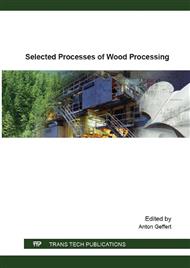[1]
I.R. Plaimer, Heaven+earth: global warming, the missing science. Connorcourt publishing. Australia, (2009).
Google Scholar
[2]
Global carbon emission. Available at: http: /co2now. org/Current-CO2/CO2-Now/global-carbon-emissions. html.
Google Scholar
[3]
Ning Zeng: Carbon sequestration via wood burial. Carbon balance management (2008) 1-12.
DOI: 10.1186/1750-0680-3-1
Google Scholar
[4]
M. Goel, Recent developments in carbon dioxide capture materials and processes for energy industry, in: N.R. Neelameggham, R.G. Reddy, C.K. Belt, E.E. Vidal, (Eds. ), Energy technology perspectives, Warrendale, 2009, pp.53-62.
Google Scholar
[5]
Global Environment Outlook, UNEP Earthscan, London, (2000).
Google Scholar
[6]
J. Michalík, What do we know on the Earth climate development? A Project of the Visegrád Foundation Warning against abrupt climate (greenhouse) changes as followed from geological knowledge of the Earth, Mineralia Slovaca 34 (2002) 135-142.
Google Scholar
[7]
J. Veizer, Y. Godderis, L. M. Francois, Evidence for decoupling of atmospheric CO2 and global climate during the Phanerozoic eon, Nature 408 (2000) 698-701.
DOI: 10.1038/35047044
Google Scholar
[8]
W.N. Kürschner, Leaf sensor for CO2 in deep time, Nature 411 (2001) 247-248.
DOI: 10.1038/35077181
Google Scholar
[9]
F. Monnin, A. Indermühle, A. Dällenbach, J. Flückiger, B. Stauffer, T.F. Stocker, D. Raynaud, J.M. Barnola, Atmospheric CO2-concentrations over the last glacial termination, Science, 291 (2001) 112-114.
DOI: 10.1126/science.291.5501.112
Google Scholar
[10]
M. Reasoner, M.A. Jodry, Rapid response of alpine timerline vegetation to the Younger Dryas climate oscillation in the Colorado Rocky Mountains, USA, Geology 28 (2000) 51-54.
DOI: 10.1130/0091-7613(2000)028<0051:rroatv>2.3.co;2
Google Scholar
[11]
V. Cílek, Ocean and atmospheric carbon dioxide (Oceán a oxid uhličitý v atmosfére), Vesmír 71 (1992) 485-490.
Google Scholar
[12]
C. Loehle, Climate change: detection and attribution of trends from long-term geologic data, Ecol. Model. 171 (2004) 433-450.
DOI: 10.1016/j.ecolmodel.2003.08.013
Google Scholar
[13]
I.G. Usoskin, S.K. Solanki, M. Schüssler, K. Mursula, K. Alanko, A Millennium scale sunspot number reconstruction: Evidence for an unusually active sun since the 1940s. Phys. Rev. Lett. 91 (2003) 1-4.
DOI: 10.1103/physrevlett.91.211101
Google Scholar
[14]
S.K. Solanki, I.G. Usoskin, B. Kromer, M. Schüssler, J. Beer, Unusual activity of the Sun during recent decades compared to the previous 11, 000 years, Nature 431 (2004) 1084-1087.
DOI: 10.1038/nature02995
Google Scholar
[15]
T. Patterson, The global record and climate change, Regulation and Reality Conference, Toronto, 2004, pp.48-59.
Google Scholar
[16]
N.J. Shaviv, J. Veizer, Celestial driver of Phanerozoic climate? Science, VII (2003) 1-9.
Google Scholar
[17]
H.N.A. Priem, Climate change: the human influence analysed. European Council of Sceptical Organizations (ESCO) on the occasion of the inauguration of the European Centre for Inquiry. Rossdorf, 2000, pp.1-9.
Google Scholar
[18]
A.Y. Davis, R. Ottmar, Y. Liu, S. Goodrick, G. Achtemeier, B. Gullett, J. Aurell, W. Stevens, R. Greenwald, Y. Hu, A. Russell, J.K. Hiers, M.T. Odman, Fire emission uncertainties and their effect on smoke dispersion predictions: a case study at Eglin Air Force Base, Florida, USA, Int. J. Wildland Fire 24 (2015).
DOI: 10.1071/wf13071
Google Scholar
[19]
IPCC Guidelines for National Greenhouse Gas Inventories, Prepared by the National Greenhouse Gas Inverventories Programe, H.S. Eggleston, Buendia L., Miwa K., Ngara T., and Tanabe K. (eds). Published: IGES, Japan, (2006).
Google Scholar
[20]
K.G. Roberts, B.A. Gloy, S. Joseph, N.R. Scott, J. Lehmann, Life cycle assessment of biochar systems: Estimatic the energetic, economic, and climate change potential, Environ. Sci. Technol. 44 (2010) 827-833.
DOI: 10.1021/es902266r
Google Scholar
[21]
J. Lehman, S. Josseph, Biochar for environmental management: science and technology, Earthscan from Routledge in the UK and USA, (2006).
Google Scholar
[22]
M.K. Herwig, U.S. Patent 5, 026, 403. (1991).
Google Scholar
[23]
A. Constantine, U.S. Patent 5, 279, 712. (1994).
Google Scholar
[24]
Y. Berman, U.S. Patent 6, 558, 644. (2003).
Google Scholar
[25]
J. Michael, Jr. Antal, U.S. Patent 6, 790, 317. (2004).
Google Scholar
[26]
P. Bober, A. Oriňák, R. Oriňáková, P. Zamostný, J. Ladomerský, A. Fedorková, Hydrogen production by catalysed pyrolysis of polymer blends, Fuel 90 (2011) 2334-2339.
DOI: 10.1016/j.fuel.2011.02.001
Google Scholar
[27]
E. Hroncová, J. Ladomerský, Model for Evaluation of Co-Combustion of Composted Sewage Sludge, in: 11th International Scientific conference MMA 2012 – Advanced production technologies, Novi Sad, Serbia, 2012, pp.343-345.
Google Scholar
[28]
J. Ladomerský, E. Hroncová, A. Košíková, Transforming Waste to Fuel Followed by Energy Production in Context of Greenhouse Gas Emissions and Air Protection, in: International conference on chemical technology (ICCT), Praha, 2013, pp.1-8.
Google Scholar
[29]
J. Hammond, S. Schackley, S. Sohi, P. Brownsort, Prospective life cycle carbon abatement for pyrolysis biochar systems (PBS) in the UK, Energy Policy, 39 (2011) 2646-2655.
DOI: 10.1016/j.enpol.2011.02.033
Google Scholar
[30]
J. Ladomerský, E. Hroncová, B. Petrík, Design and implementation of a two-stage thermal reactor to minimize organic compounds emitted in the production of charcoal. Adidovce, 2004 (unpublished).
Google Scholar
[31]
J.C. Adam, Improved and more environmentally friendly charcoal production system using a low-cost retort–kiln (Eco-charcoal). Renewable Energy 34 (2009) 1923–(1925).
DOI: 10.1016/j.renene.2008.12.009
Google Scholar
[32]
E. Hroncová, J. Ladomerský, C. Adam, Inovative pyrolysis technique for biochar production with regard to reduced emissions of pollutants and greenhouse gases. Scientific Monograph. Zvolen: Technical University in Zvolen, Slovakia, (2013).
Google Scholar
[33]
E. Hroncová, J. Ladomerský, C. Adam, The use of wood from degraded land for carbon sequestration, Drewno 56 (2013) 51-61.
Google Scholar
[34]
M.M. Titirici, A. Thomas, M. Antonietti, Back in the black: hydrothermal carbonization of plant material as an efficient chemical process to treat the CO2 problem? New J. Chem. 31 (2007) 787-789.
DOI: 10.1039/b616045j
Google Scholar
[35]
European Biochar Certificate-Guidelines for a Sustainable Production of Biochar, European Biochar Foundation (EBC), Arbaz, Switzerland, (2012).
Google Scholar
[36]
J. Ladomerský, E. Hroncová, D. Samešová, K. Kočík, SK Patent 288, 265. (2015).
Google Scholar


